In the diverse ecosystems of Florida, eleven owl species gracefully navigate the night, each contributing to the state’s rich biodiversity.
These nocturnal creatures embody nature’s wonders, from the iconic Great Horned Owl to the elusive Stygian Owl.
This exploration unveils the enchanting world of Florida’s owl species, providing insight into their unique characteristics, habitats, and the vital roles they play in maintaining ecological balance.
As we delve into the intricacies of their lives, we discover the resilience of these feathered inhabitants amidst environmental changes.
Join us on a journey through the moonlit landscapes of Florida, where the silent wings and haunting calls of these eleven owl species echo the beauty and mystery of the state’s wild spaces. Stay focused.
11 Owls Of Florida
Explore Florida’s diverse owl species, each with unique adaptations and roles in the ecosystem. From the elusive Stygian Owl to the adaptable Barred Owl, uncover the intriguing lifestyles of these feathered inhabitants.
Delve into their habitats, feeding habits, and conservation status as we navigate the fascinating world of Florida’s owls.
1. Great Horned Owl
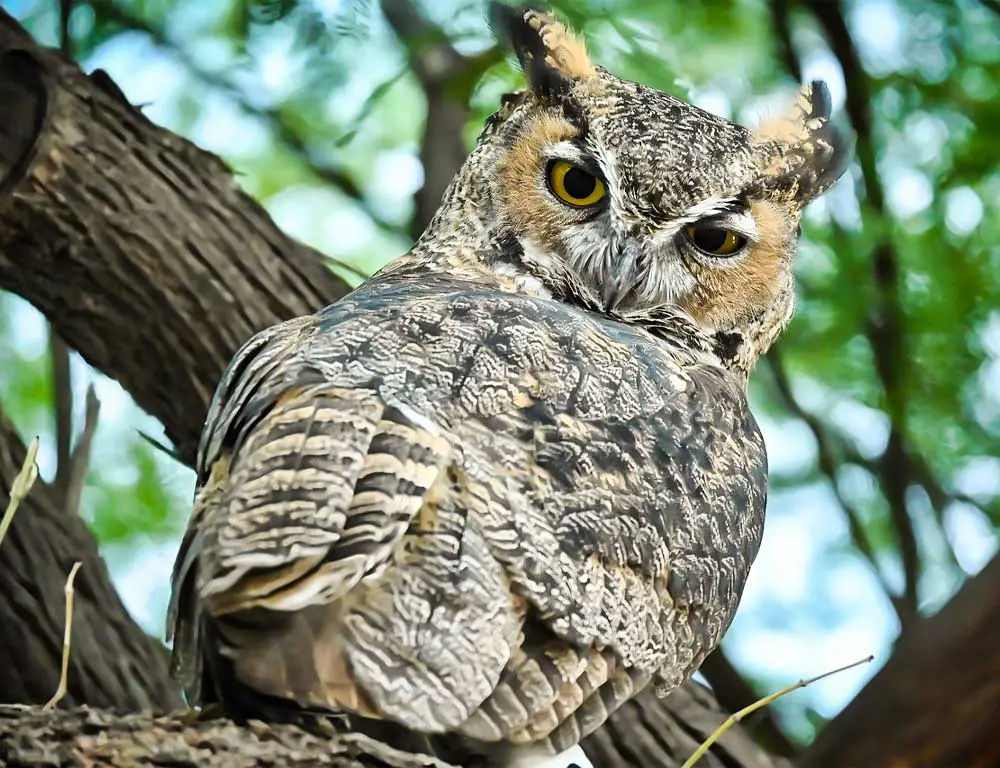
- Scientific name: Bubo virginianus
- Category: Strigidae
- Population: Common and widespread
- Life span: Up to 15 years in the wild
- Size: 18-25 inches
- Weight: 2-5.5 pounds
- Food: Varied diet including small mammals, birds, and reptiles
- Wingspan: 3.3 to 4.8 feet
- Status: Secure
The Great Horned Owl, a formidable nocturnal predator, thrives in Florida’s diverse habitats.
It is a charismatic species with its large size, distinctive ear tufts, and piercing yellow eyes. Their adaptability allows them to inhabit forests, deserts, and urban areas.
As skilled hunters, they primarily prey on small mammals like rodents, rabbits, and birds, using their strong talons to grasp and kill with precision.
These owls are monogamous, forming lasting bonds with their mates. Nesting in tree branches or abandoned nests, they fiercely protect their territory.
Their haunting hoots resonate through the night, serving as territorial calls and communication with their mates.
The Great Horned Owl’s population remains healthy, and its ability to adjust to diverse environments ensures its continued presence in Florida’s ecosystems.
As apex predators, they play a crucial role in maintaining a balanced ecosystem by controlling rodent populations.
2. Eastern Screech Owl
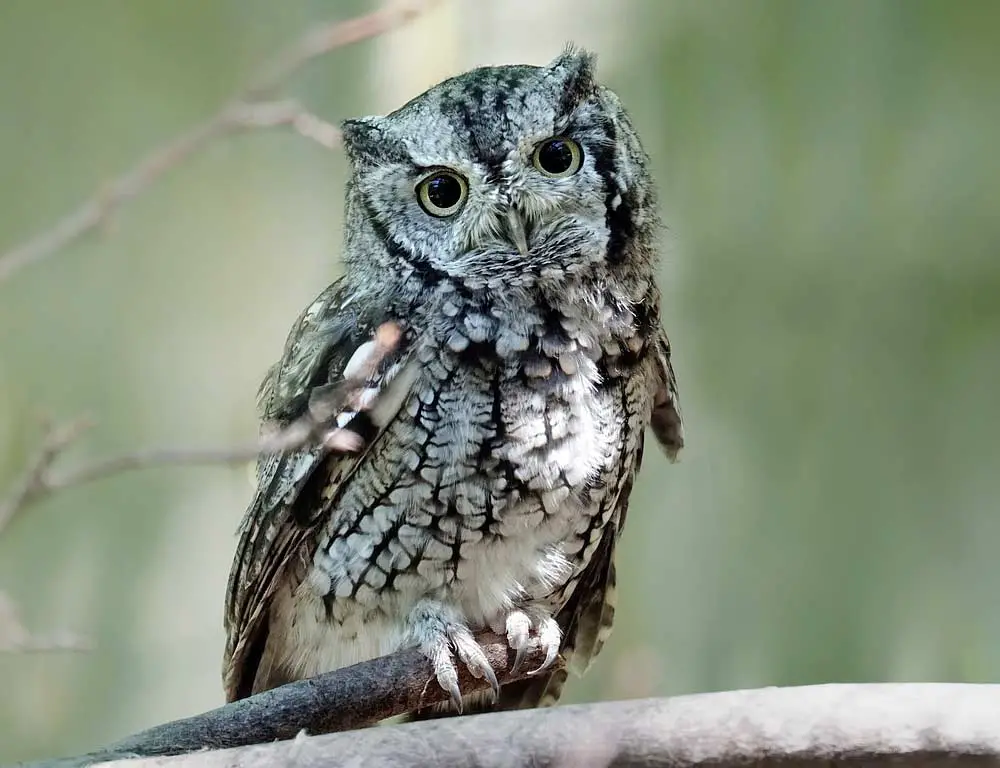
- Scientific name: Megascops asio
- Category: Strigidae
- Population: Stable
- Life span: Up to 14 years in the wild
- Size: 6-10 inches
- Weight: 4-9 ounces
- Food: Small mammals, birds, insects
- Wingspan: 18-24 inches
- Status: Least Concern
The Eastern Screech Owl, a diminutive but captivating owl species in Florida, exhibits remarkable adaptability. With its mottled plumage providing excellent camouflage, these owls are masterful at blending into their surroundings.
They inhabit various habitats, including woodlands, parks, and suburban areas, where they find suitable roosting spots in tree cavities.
Feeding primarily on small mammals, birds, and insects, they are skilled nocturnal hunters. Their haunting trill and distinctive whinny sounds fill the night, serving as both communication and territorial markers.
Eastern Screech Owls are cavity nesters, often utilizing abandoned woodpecker holes or nest boxes. They display strong family bonds, with parents sharing responsibilities in raising and protecting their young.
Despite habitat loss and urbanization challenges, the Eastern Screech Owl’s population remains stable.
Their adaptability to coexist with humans in urban environments contributes to their continued presence in Florida’s diverse ecosystems. Conservation efforts and awareness play vital roles in ensuring the well-being of these enchanting birds.
3. Snowy Owl
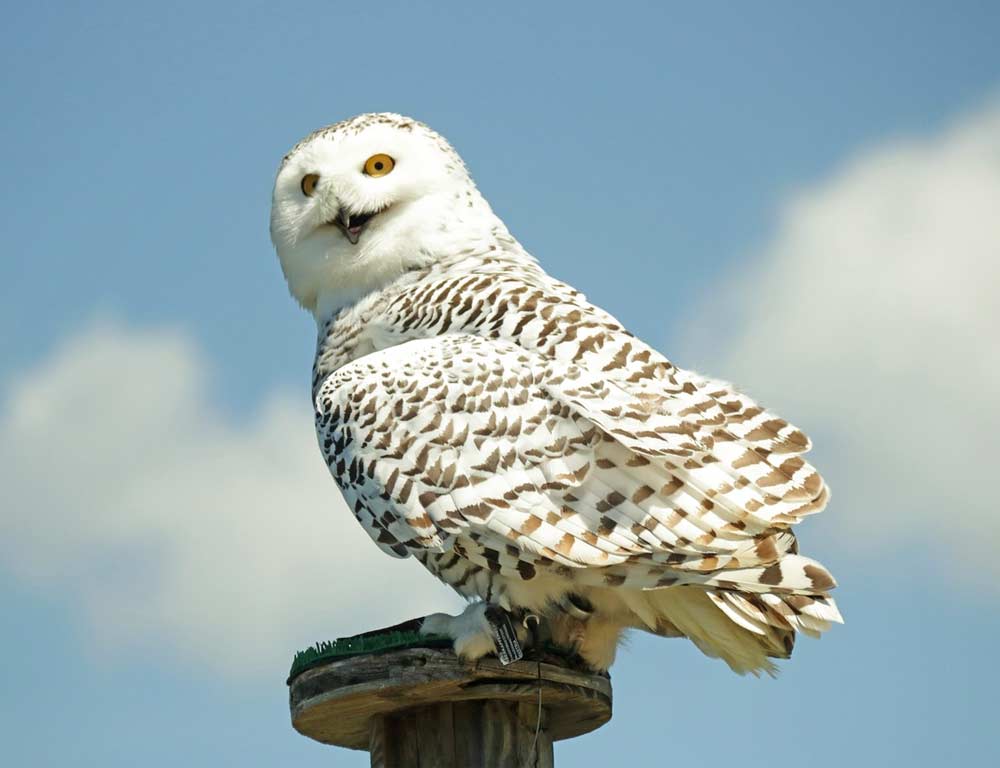
- Scientific name: Bubo scandiacus
- Category: Strigidae
- Population: Varies, occasional winter visitors to Florida
- Life span: Up to 10 years in the wild
- Size: 20-28 inches
- Weight: 3.5-6.6 pounds
- Food: Mainly lemmings, also birds and small mammals
- Wingspan: 49-59 inches
- Status: Vulnerable
The Snowy Owl, a majestic Arctic species, occasionally graces Florida as a winter visitor. Known for its striking white plumage and vibrant yellow eyes, these owls are highly adapted to cold climates. Their large size and broad wingspan make them impressive in flight.
In Florida, they can be spotted in coastal areas, fields, and grasslands during winter months, escaping the harsh Arctic conditions. Snowy Owls primarily feed on lemmings, but their diet may include birds and small mammals when lemming populations are scarce.
Their migratory patterns are influenced by food availability, with some individuals venturing far south in search of suitable prey.
Snowy Owls are solitary birds, with males displaying territorial behavior during breeding seasons in the Arctic. Conservation efforts are crucial for their survival, as climate change and human disturbances in their Arctic habitats pose threats.
The occasional presence of Snowy Owls in Florida serves as a reminder of the interconnectedness of ecosystems and the importance of preserving diverse habitats for these magnificent birds.
4. Long-eared Owl
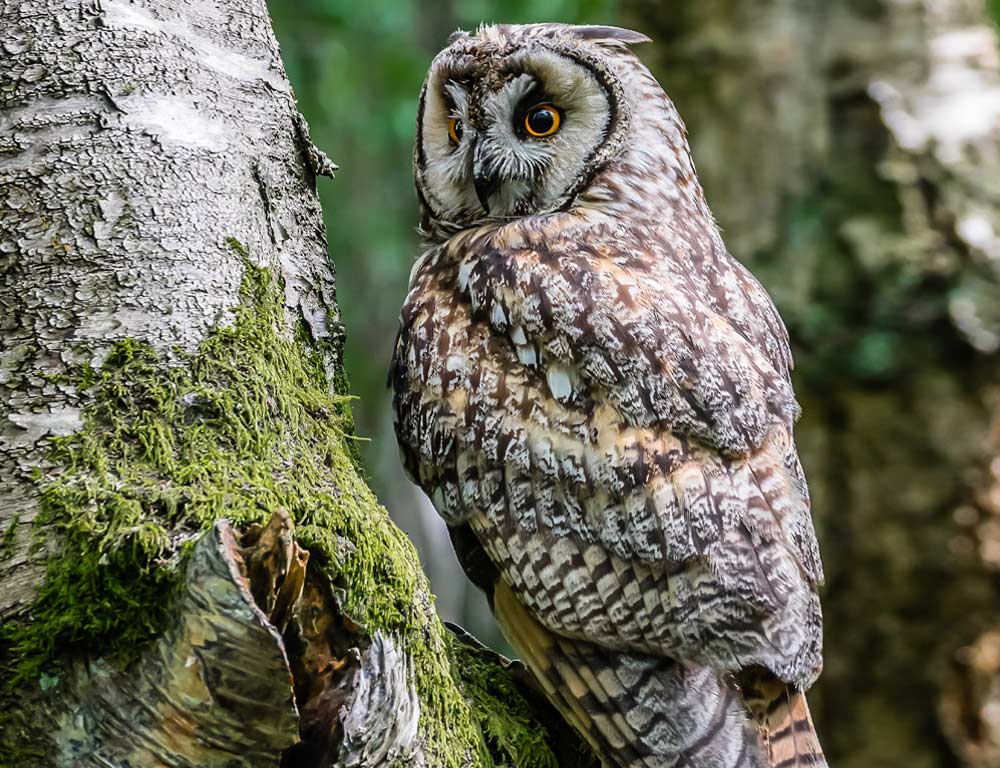
- Scientific name: Asio otus
- Category: Strigidae
- Population: Stable but localized and can be patchy
- Life span: Up to 10 years in the wild
- Size: 13-16 inches
- Weight: 7-15 ounces
- Food: Small mammals, birds, insects
- Wingspan: 35-39 inches
- Status: Least Concern
The Long-eared Owl, with its distinctive “ear” tufts and mottled plumage, is an elusive nocturnal hunter in Florida’s diverse landscapes.
Preferring woodlands and forests, they roost in dense foliage during the day, camouflaging effectively with their surroundings. These owls exhibit a nomadic lifestyle, often relocating based on prey availability.
Feeding primarily on small mammals, birds, and insects, Long-eared Owls use their keen hearing and sharp vision for nocturnal hunting.
During breeding, males display territorial behavior with hoots and flight displays to attract mates. They construct nests in trees or repurpose abandoned nests from other birds.
While the overall population is considered stable, localized fluctuations can occur. Habitat preservation and minimizing disturbances are essential for the Long-eared Owl’s well-being.
Conservation efforts focus on protecting their nesting sites and raising awareness about the importance of these owls in maintaining a balanced ecosystem.
5. Burrowing Owl
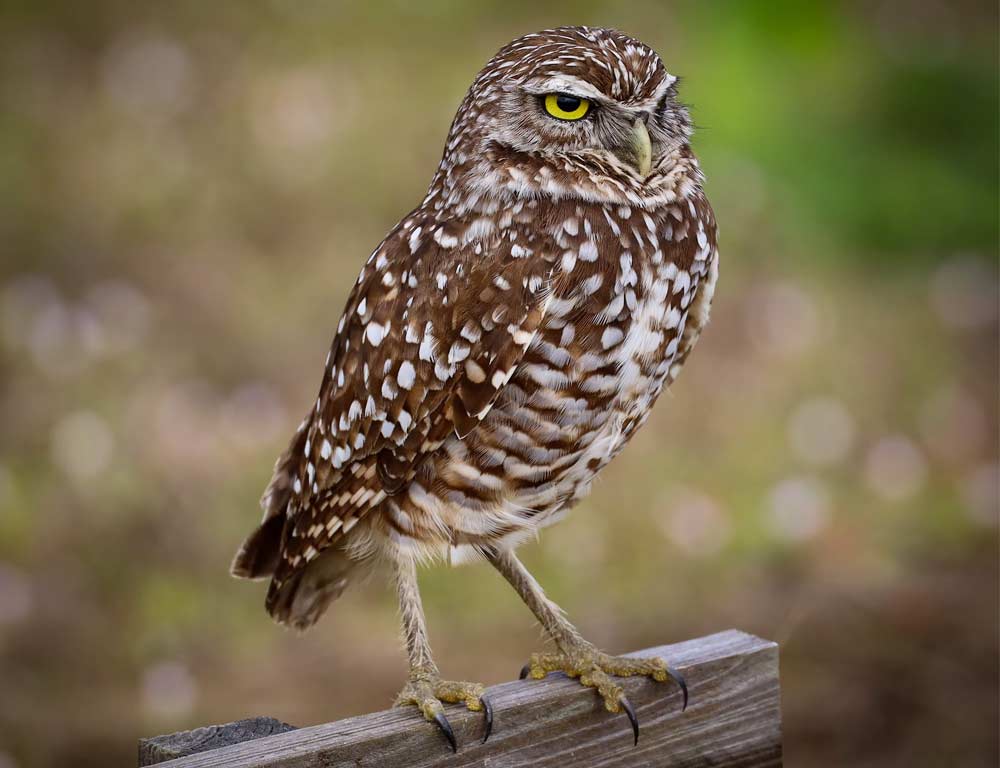
- Scientific name: Athene cunicularia
- Category: Strigidae
- Population: Declining, listed as a Species of Special Concern in Florida
- Life span: Up to 9 years in the wild
- Size: 7-10 inches
- Weight: 5-6 ounces
- Food: Insects, small mammals, reptiles
- Wingspan: 21-24 inches
- Status: Vulnerable in some regions
The Burrowing Owl, characterized by its long legs and distinctive habit of nesting in burrows, is a charming and diminutive owl species in Florida.
Found in open grasslands, prairies, and agricultural areas, they create burrows or utilize existing ones to shelter themselves and their young.
Burrowing Owls are opportunistic hunters with a diet consisting mainly of insects, small mammals, and reptiles, relying on their keen vision and agility.
They are known for their distinctive bobbing head movements and expressive calls. These owls exhibit a communal nesting behavior, with multiple pairs often sharing a burrow system.
Despite their adaptable nature, Burrowing Owls face threats from habitat loss due to urbanization and agriculture. The decline in available nesting sites and increased human-wildlife conflicts contribute to their vulnerability.
Conservation efforts focus on preserving open habitats, establishing artificial burrows, and raising awareness to mitigate the challenges faced by these captivating birds.
6. Short-eared Owl
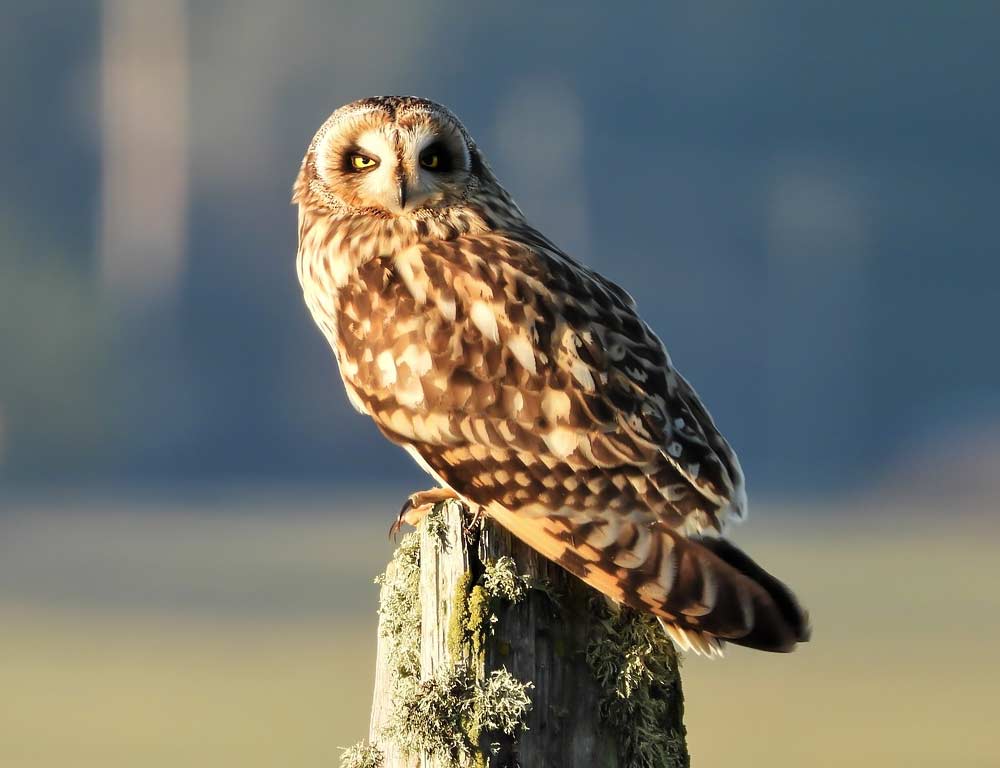
- Scientific name: Asio flammeus
- Category: Strigidae
- Population: Declining, considered a Species of Special Concern in Florida
- Life span: Up to 10 years in the wild
- Size: 13-17 inches
- Weight: 7-17 ounces
- Food: Small mammals, birds
- Wingspan: 33-43 inches
- Status: Vulnerable
The Short-eared Owl, named for its short ear tufts, is a grassland dweller with a widespread but declining presence in Florida.
Their habitats include marshes, meadows, and coastal areas, where they exhibit a unique hunting behavior, flying low over open terrain in search of small mammals and birds.
Active daily and night, Short-eared Owls are social birds, often congregating in loose groups. Their breeding season involves aerial displays and vocalizations to attract mates.
Nesting occurs on the ground in well-hidden locations, typically using existing vegetation for cover.
Despite their adaptability, Short-eared Owls face threats from habitat loss, disturbance, and changes in agricultural practices. The decline in suitable breeding grounds contributes to their status as a Species of Special Concern.
Conservation efforts focus on habitat restoration, protecting nesting sites, and promoting sustainable land management practices to ensure the survival of these captivating birds.
7. Flammulated Owl
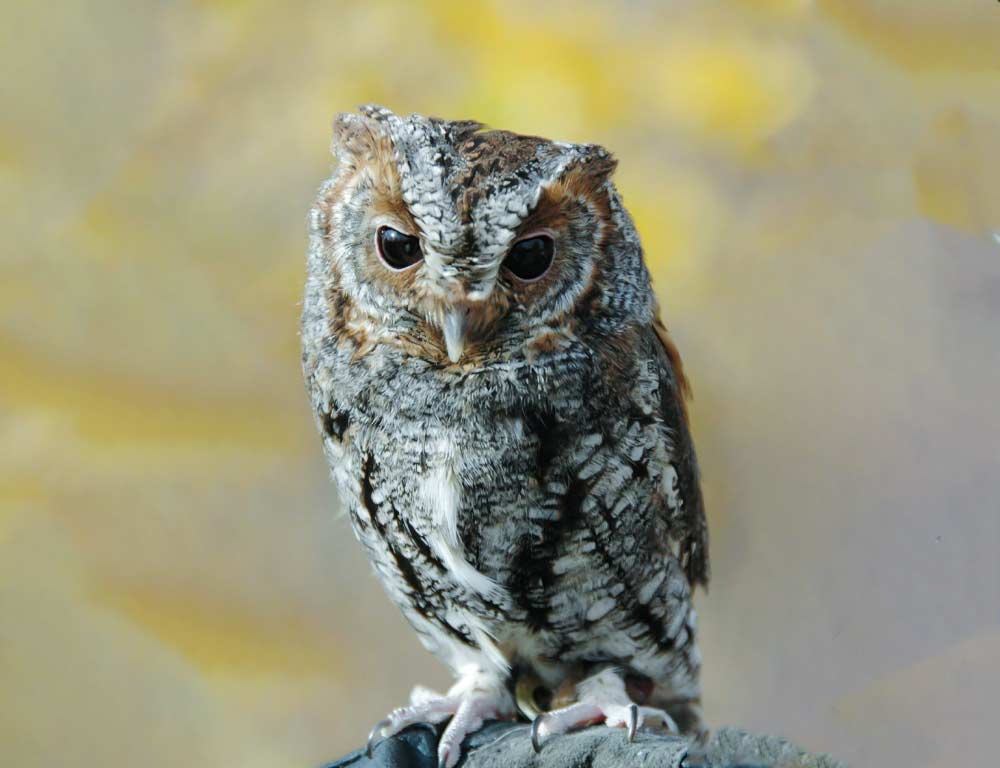
- Scientific name: Psiloscops flammeolus
- Category: Strigidae
- Population: Stable, but limited and not well-studied
- Life span: Up to 8 years in the wild
- Size: 6-7 inches
- Weight: 1.5-2.5 ounces
- Food: Insects, small vertebrates
- Wingspan: 15-18 inches
- Status: Least Concern
The Flammulated Owl is a small and elusive species known for its mottled brown plumage and relatively diminutive size. They inhabit coniferous and mixed forests in Florida, particularly during the breeding season.
These owls are challenging to study due to their secretive nature and nocturnal habits.
With a diet mainly comprising insects and small vertebrates, Flammulated Owls employ silent flight and keen hearing to hunt effectively. Their small size allows them to navigate dense foliage in search of prey.
During breeding, males vocalize to attract mates, and nesting occurs in tree cavities or abandoned woodpecker holes.
While considered stable overall, the limited data on Flammulated Owls in Florida underscores the need for further research and conservation efforts.
Preserving suitable habitats, especially mature forests with ample tree cavities, is crucial for their continued well-being. Public awareness and responsible forest management contribute to conserving these enigmatic owls in the Sunshine State.
8. Northern Saw-whet Owl
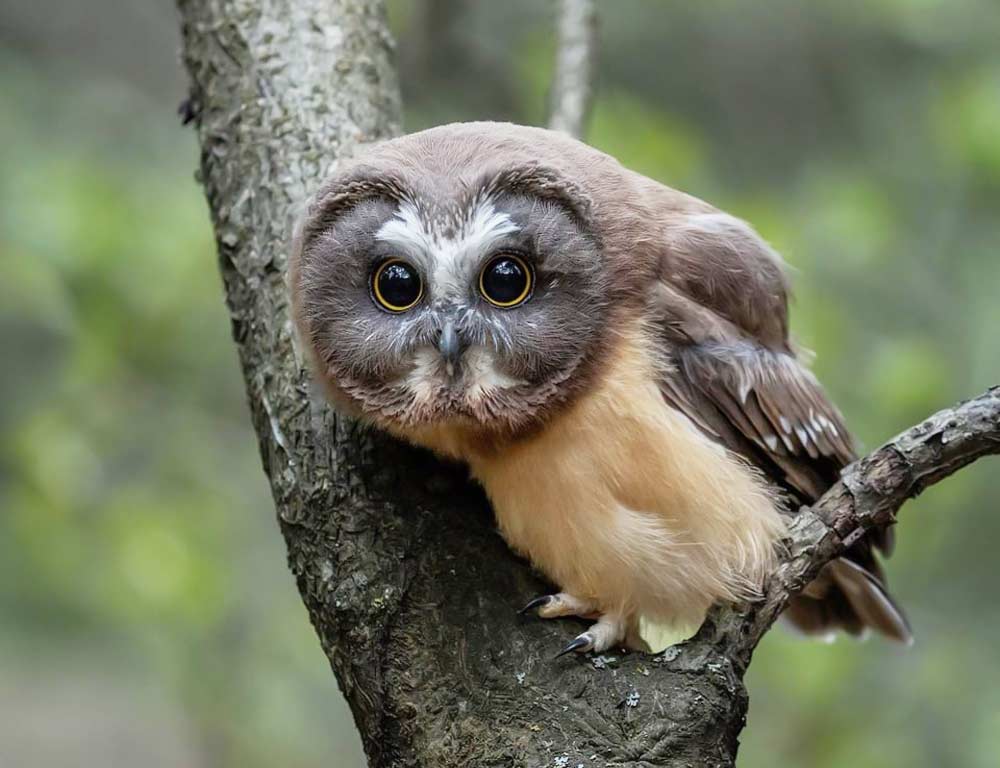
- Scientific name: Aegolius acadicus
- Category: Strigidae
- Population: Stable, but some regional declines
- Life span: Up to 7 years in the wild
- Size: 7-8 inches
- Weight: 2-5 ounces
- Food: Small mammals, birds, insects
- Wingspan: 16-18 inches
- Status: Least Concern
The Northern Saw-whet Owl, named for its distinctive “sawing” call reminiscent of a whetstone, is a petite and nocturnal species found in coniferous and mixed forests.
Their excellent camouflage, marked by intricate plumage patterns, allows them to blend seamlessly with their surroundings.
Feeding primarily on small mammals, birds, and insects, Saw-whet Owls are adept hunters, using their keen hearing and vision to locate prey. Their nesting sites are often in tree cavities or abandoned woodpecker holes.
During the breeding season, males produce repetitive hooting calls to attract females, engaging in courtship displays.
While the overall population is considered stable, regional declines have been observed, necessitating conservation efforts.
Protecting mature forests and raising awareness about the importance of these small owls in maintaining ecosystem balance contribute to their continued presence in the northern regions of the United States, including parts of Florida.
9. Barred Owl
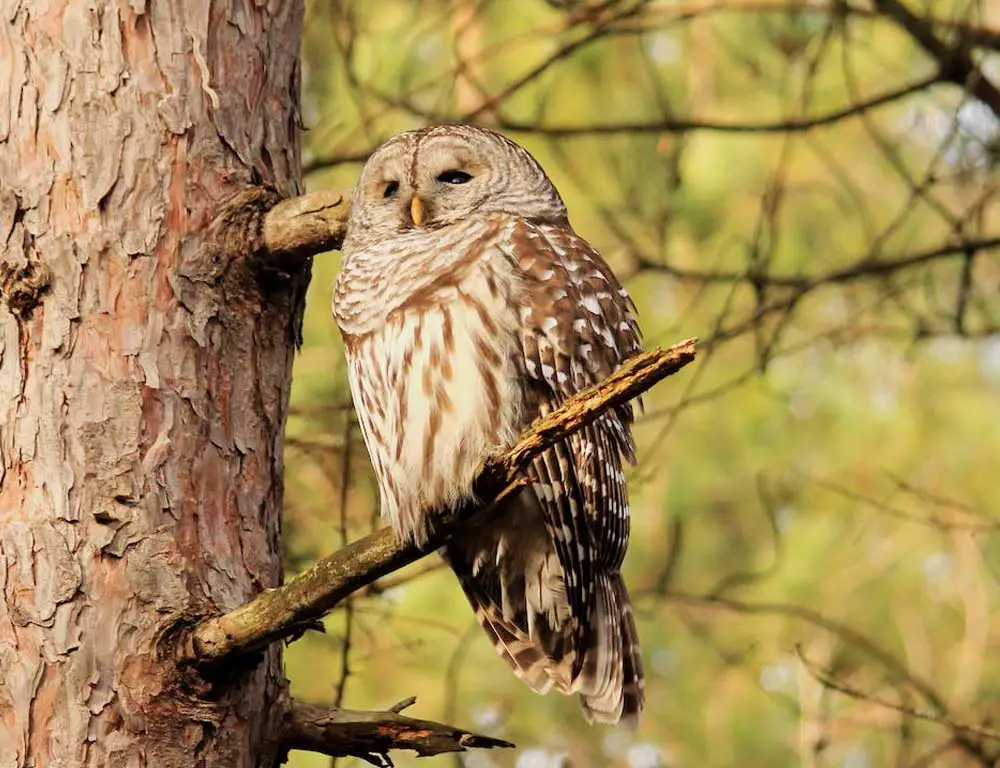
- Scientific name: Strix varia
- Category: Strigidae
- Population: Stable, adaptable to various habitats
- Life span: Up to 10 years in the wild
- Size: 16-25 inches
- Weight: 1-2.5 pounds
- Food: Small mammals, birds, amphibians
- Wingspan: 38-49 inches
- Status: Least Concern
The Barred Owl, recognized for its striking barred plumage and distinctive hooting calls, is a versatile and adaptable owl species in Florida.
Found in various habitats, including forests, swamps, and suburban areas, they have successfully adjusted to human-altered landscapes.
Feeding on small mammals, birds, and amphibians, Barred Owls are effective hunters, often seizing prey with their strong talons.
Their territorial hooting calls resonate through the night and display strong family bonds during the breeding season. Nesting occurs in tree cavities or abandoned nests, and both parents contribute to raising and protecting their young.
While the Barred Owl population is generally stable, they face threats from habitat loss and competition with the closely related Spotted Owl.
Conservation efforts focus on preserving diverse habitats, minimizing habitat fragmentation, and addressing the potential impacts of urbanization on these adaptable and resilient owls.
10. Barn Owl
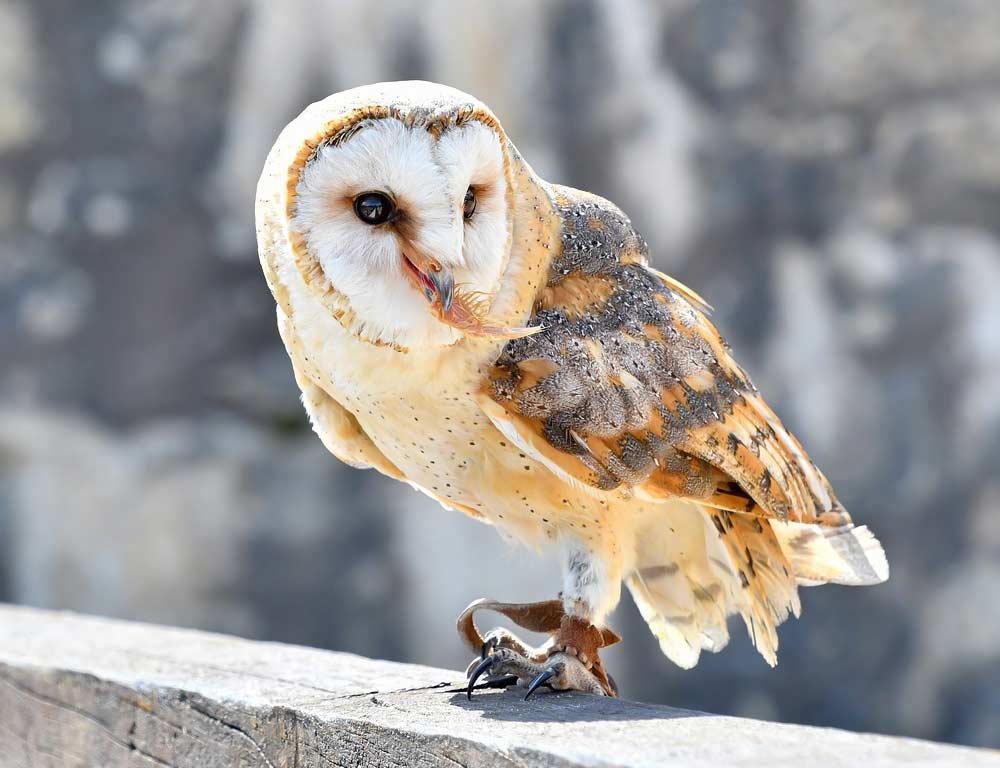
- Scientific name: Tyto alba
- Category: Tytonidae
- Population: Stable, but some regional declines
- Life span: Up to 10 years in the wild
- Size: 12-16 inches
- Weight: 12-25 ounces
- Food: Small mammals, birds, rodents
- Wingspan: 42-47 inches
- Status: Least Concern
The Barn Owl, recognized for its heart-shaped facial disc and distinctive screeching calls, is a nocturnal predator with a global distribution, including Florida.
Their pale plumage and unique facial structure enhance their ability to navigate and hunt in low-light conditions.
Feeding primarily on small mammals, birds, and rodents, Barn Owls are vital in controlling rodent populations, making them valuable for agricultural and ecosystem health.
They nest in structures such as barns, abandoned buildings, or tree cavities, and their pellets, regurgitated indigestible parts of prey, provide valuable insights into local prey species.
While the overall population is considered stable, regional declines have been reported due to habitat loss and pesticide use affecting prey availability.
Conservation efforts involve providing nesting boxes, protecting roosting sites, and raising awareness about the ecological importance of Barn Owls in maintaining a balance between predators and prey in Florida’s diverse landscapes.
11. Stygian Owl
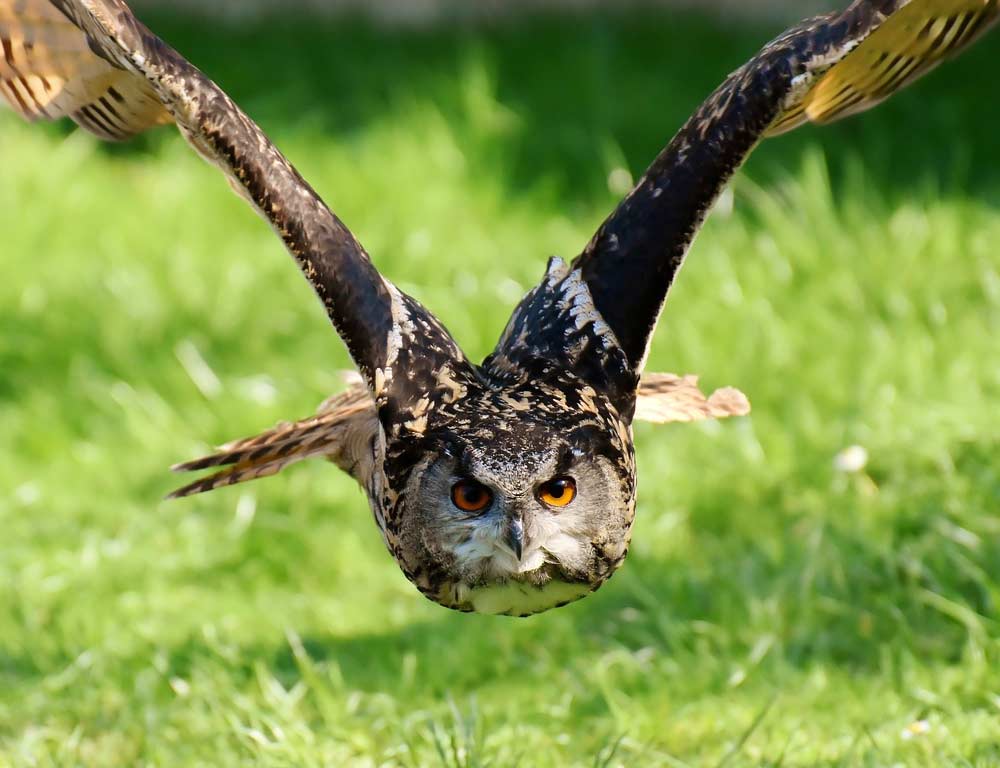
- Scientific name: Asio stygius
- Category: Strigidae
- Population: Insufficient data, potentially declining
- Life span: Up to 10 years in the wild
- Size: 15-17 inches
- Weight: 12-18 ounces
- Food: Small mammals, birds, insects
- Wingspan: 36-40 inches
- Status: Data Deficient
The Stygian Owl, a mysterious and seldom-studied species, is found in tropical and subtropical forests, including parts of Florida.
Named for the river Styx from Greek mythology, these owls are known for their dark plumage and elusive nature.
Feeding on small mammals, birds, and insects, Stygian Owls are skilled nocturnal hunters, relying on their keen senses to locate prey.
Their nesting habits and breeding behaviors are not well-documented due to their elusive nature.
The lack of comprehensive data on their population trends and ecological requirements makes it challenging to assess their conservation status accurately.
Given the limited information available, conservation efforts for the Stygian Owl involve habitat preservation, especially in tropical and subtropical forest ecosystems.
Research initiatives to understand their ecology, behavior, and population dynamics are crucial for developing effective conservation strategies and ensuring the long-term survival of this enigmatic owl species in Florida.
Wrapping Up
In the enchanting realm of Florida’s nocturnal skies, the Owls of Florida captivate with their diverse lifestyles.
From the adaptable Barred Owl to the elusive Stygian Owl, these feathered inhabitants play integral roles in maintaining ecological balance.
As we’ve unveiled their unique characteristics, nesting habits, and the challenges they face, it becomes evident that our commitment to habitat preservation is crucial.
Understanding and appreciating these owls enriches our knowledge of local wildlife and underscores the importance of conservation efforts.
By embracing responsible practices and raising awareness, we can ensure a harmonious coexistence with these captivating creatures, preserving the rich biodiversity that defines Florida’s landscapes. Thank you so much.